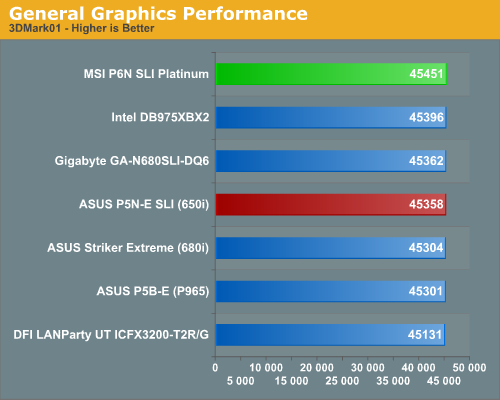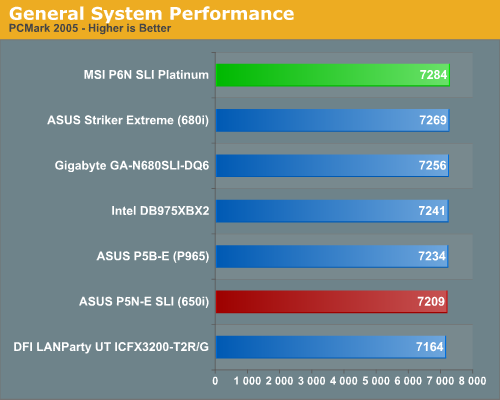MSI P6N SLI Platinum: NVIDIA's 650i Part Two
by Gary Key on March 13, 2007 1:00 AM EST- Posted in
- Motherboards
Synthetic Graphics Performance
The 3DMark series of benchmarks developed and provided by Futuremark are among the most widely used tools for benchmark reporting and comparisons. Although the benchmarks are very useful for providing apples-to-apples comparisons across a broad array of GPU and CPU configurations they are not a substitute for actual application and gaming benchmarks. In this sense we consider the 3DMark benchmarks to be purely synthetic in nature, but they are still very valuable for providing consistent measurements of performance.


In our 3DMark06 test, each platform score is basically the same, though we see the DFI RD600 based motherboard trailing slightly. We attribute this to the slightly lower memory and video performance results in our latest BIOS release. Our MSI board tops the chart and offers the best CPU performance of our test boards in this benchmark.
In the more memory and CPU sensitive 3DMark01 benchmark we see our MSI 650i board topping the Intel 975X board, but the Sandra memory bandwidth results still greatly favor the 975x platform. Our Sandra memory bandwidth scores along with Memtest86 testing also consistently show the RD600 performing slightly better than the 680i or 650i, but our 3DMark01 benchmark does not show this advantage. Generally, NVIDIA based chipsets perform very well in graphics tests and the scores from our MSI P6N SLI Platinum indicate a highly tuned platform. We will see this pattern continue for the most part in our other tests.
Synthetic System Performance
The PCMark05 benchmark developed and provided by Futuremark was designed for determining overall system performance for the typical home computing user. This tool provides both system and component level benchmarking results utilizing subsets of real world applications or programs. This benchmark is useful for providing comparative results across a broad array of Graphics subsystems, CPU, Hard Disk, and Memory configurations along with multithreading results. In this sense we consider the PCMark benchmark to be both synthetic and real world in nature, and it again provides consistency in our benchmark results.

The MSI 650i board once again tops our charts is very competitive in this benchmark, although we expected slightly better results based upon our application results. The 650i and 680i chipsets scored very well on the single task disk benchmarks and both performed almost equally on the graphics subsystem tests where they led the field. However, our 975X and P965 chipset boards won the multitasking tests while the RD600 finished in the middle on most of the tests.
The 3DMark series of benchmarks developed and provided by Futuremark are among the most widely used tools for benchmark reporting and comparisons. Although the benchmarks are very useful for providing apples-to-apples comparisons across a broad array of GPU and CPU configurations they are not a substitute for actual application and gaming benchmarks. In this sense we consider the 3DMark benchmarks to be purely synthetic in nature, but they are still very valuable for providing consistent measurements of performance.


In our 3DMark06 test, each platform score is basically the same, though we see the DFI RD600 based motherboard trailing slightly. We attribute this to the slightly lower memory and video performance results in our latest BIOS release. Our MSI board tops the chart and offers the best CPU performance of our test boards in this benchmark.
In the more memory and CPU sensitive 3DMark01 benchmark we see our MSI 650i board topping the Intel 975X board, but the Sandra memory bandwidth results still greatly favor the 975x platform. Our Sandra memory bandwidth scores along with Memtest86 testing also consistently show the RD600 performing slightly better than the 680i or 650i, but our 3DMark01 benchmark does not show this advantage. Generally, NVIDIA based chipsets perform very well in graphics tests and the scores from our MSI P6N SLI Platinum indicate a highly tuned platform. We will see this pattern continue for the most part in our other tests.
Synthetic System Performance
The PCMark05 benchmark developed and provided by Futuremark was designed for determining overall system performance for the typical home computing user. This tool provides both system and component level benchmarking results utilizing subsets of real world applications or programs. This benchmark is useful for providing comparative results across a broad array of Graphics subsystems, CPU, Hard Disk, and Memory configurations along with multithreading results. In this sense we consider the PCMark benchmark to be both synthetic and real world in nature, and it again provides consistency in our benchmark results.

The MSI 650i board once again tops our charts is very competitive in this benchmark, although we expected slightly better results based upon our application results. The 650i and 680i chipsets scored very well on the single task disk benchmarks and both performed almost equally on the graphics subsystem tests where they led the field. However, our 975X and P965 chipset boards won the multitasking tests while the RD600 finished in the middle on most of the tests.










20 Comments
View All Comments
nicolasb - Tuesday, March 13, 2007 - link
Maybe this was mentioned in part 1 and I missed it, but how does the 650i perform in terms of heat output? And how effective/noisy is the north bridge cooling on the MSI board? And how does the overall power consumption of the system compare to P965? The 680i certainly runs very hot indeed compared to its Intel rivals;I think need to know if the 650i does the same.Gary Key - Tuesday, March 13, 2007 - link
Power consumption numbers are on page 9. Thermals are a different story as they will vary widely depending upon the case design and internal cooling. The best I can do is to setup a 650i and a P965 on a test platform and take readings without any airflow across the boards. I will do that tonight but from the touch of your finger testing, I figure the 650i is about 15% warmer on average. The fan that MSI includes has a db rating of 34 and did not sound whiny in testing.nicolasb - Tuesday, March 13, 2007 - link
I think we need to know, even.Geraldo8022 - Tuesday, March 13, 2007 - link
Yes, this is very important to me and I also would like the answers to these questions.phusg - Tuesday, March 13, 2007 - link
Guys I agree it's very important but please RTFA first ;-)From page 9 power consumption you can conclude that the 650i uses some 10-15 Watts less than the 690i.
phusg - Tuesday, March 13, 2007 - link
Additionally if idle is more important to you then the P965 seems to nose in front, if load is more important then the RD600 chipset seems to be king. Unfortunately only DFI has a board at the moment although I think ASUS is rumoured to be preparing one too.And as far as noise goes I think all these motherboards are passively cooled, so they should be pretty close to 0db.
yyrkoon - Tuesday, March 13, 2007 - link
First, let me get this out of the way:Last page second to the last paragraph, I'm assuming you meant 'knock-out blow' ?
Now that, that is out of the way, is it just me, or does it seem that MSI is/has been encroaching on ABIT, and like companies as far as stability goes ? I personaly have not owned any MSI motherboards for quite some time, but everytime I read about their boards, it seems to be getting more, and more favorable for them.
Now a question concerning functionality. Will this SIL eSATA chip handle SATA Port multipliers well ? Would be a very good option if so. Also how many PCIE lanes do these boards actually use vs the i680 boards ? I remember seeing a spec sheet of the 590 vs the 570 (which if I recall correctly, was half the PCIE lanes, 590 vs 570 that is) but I do not recall seeing any data concerning the i680 vs its little breathren.
Gary Key - Tuesday, March 13, 2007 - link
Hi,It should have been knock-out blow and is corrected now. On the front page we linked to our 680i launch article that explained the technical differences between the chipsets - http://www.anandtech.com/cpuchipsets/showdoc.aspx?...">680i Launch - but to answer your question quickly the 680i has 46 PCI Express Lanes and nine links compared to 18 PCI Express Lanes and four links on the 650i SLI. The specs on the SIL3531 can be found here - http://www.siliconimage.com/products/product.aspx?...">SiL3531. The chipset has support for Port Multipliers with FIS-based switching such as their own SiL3726 chipset.
MSI over the last couple of years had lost their focus to some degree in the motherboard market and it seemed as though they either wanted to product low cost boards to compete against ECS/Foxconn or high-end boards in their Diamond series. You never knew what to expect from them when a new chipset was released. They were also getting a bad rap for being late to market along with getting the board finally tuned correctly about the time production ended on it. I know from several discussions with them over the past couple of months that they are aware of past issues and are vigorously working to correct those issues now. Product quality has always been good overall but has certainly become better as of late while pricing is still aggressive based upon feature sets.
Thanks for the comments.
yyrkoon - Tuesday, March 13, 2007 - link
Thanks for the reply Gary.Am I right in assuming that just because a given chipset has x mount of PCIE lanes/Links, that <insert OEM> motherboard manufactuer is not obligated in using all of these lanes /links ? IF this be the case, how would one go about finding this information out, without reverse engineering the motherboard ?
just4U - Wednesday, March 21, 2007 - link
Odd is it not? They used to be first to market in alot of boards and had to constantly fine tune after launch because they were riddled with issues. I've always liked MSI and usually purchase a few of their boards each year.